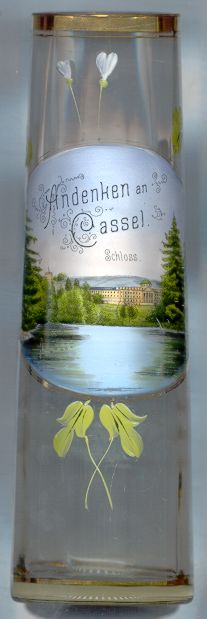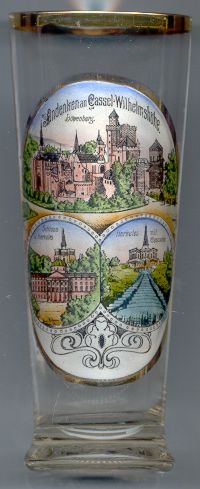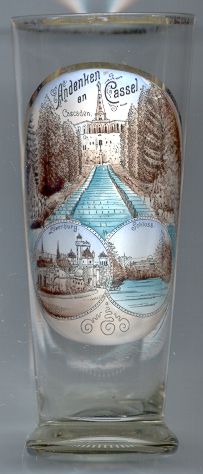

|
| DEUTSCHLAND | GERMANY |
| Bundesland: Hessen | Hesse |
| Regierungsbezirk: Kassel | |
| Stadt: Kassel |
Kassel (until 1926 Cassel) is situated at an elevation of 166 m on the river Fulda in northern Hesse. The city of Kassel is administered as a district in its own right, and is also the seat of the administration of the district (Landkreis) Kassel and the administrative region Kassel. The city has a population of 193,500 (2006).
 The earliest documents mentioning Chassalla or Chassella date from 913 AD.
In 1189 Kasel was chartered as a town and in 1277 became the capital of the landgraviate Hesse.
In the 16th century, Landgrave Philipp I ('the Magnanimous') became one of the leading figures of the Reformation.
After his death in 1567 the landgraviate was partitioned among his sons Wilhelm IV (Hesse-Cassel),
Ludwig IV (Hesse-Marburg), Philipp II (Hesse-Rheinfels; see Sankt Goar) and
Georg I (Hesse-Darmstadt).
The architecture of the city was shaped in Baroque style especially during the reign of Landgrave
Karl of Hesse-Cassel (ruled 1670–1730). Under Friedrich II of Hesse-Cassel (r. 1760–1785) about 19,000 men
were leased in 1776–1783 as soldiers to Friedrichs brother-in-law, George III of the United Kingdom (also Elector, 1815 King, of Hannover),
to serve on the British side in the American War of Independence. Following the Reichsdeputationshauptschluss of 1803
the landgraviate was elevated to an electorate, but already 1806 it was occupied by French troops. In 1807 Cassel
became the capital of the Napoleonic Kingdom of Westphalia, which consisted of the Electorate of Hesse, the Duchy of
Braunschweig, and smaller parts of Hannover and Prussia. Napoleon's youngest brother,
Jérôme Bonaparte, ruled as King of Westphalia until 1813 when, after the Battle of Leipzig,
the kingdom disintegrated and the old states were re-established. Although the Holy Roman Empire had ended in 1806,
Elector Wilhelm I retained the title 'elector'. As Friedrich Wilhelm I had sided with Austria in the
Austro-Prussian War of 1866, his country was annexed by Prussia in 1866 and, together with the former duchy
of Nassau, became the Prussian province Hessen-Nassau. During the Nazi period, Kassel was the capital of the Reichsgau
Kurhessen (without the districts Schmalkalden, Schlüchtern and Gelnhausen). In 1945, Kurhessen
was incorporated into the new German state of Groß-Hessen, which in 1946 was renamed Hessen. In 1948 Kassel unseccessfully
campaigned for becoming the capital of the Federal Republic of Germany. Today, Kassel is renowned for its art exhibition
'documenta'.
The earliest documents mentioning Chassalla or Chassella date from 913 AD.
In 1189 Kasel was chartered as a town and in 1277 became the capital of the landgraviate Hesse.
In the 16th century, Landgrave Philipp I ('the Magnanimous') became one of the leading figures of the Reformation.
After his death in 1567 the landgraviate was partitioned among his sons Wilhelm IV (Hesse-Cassel),
Ludwig IV (Hesse-Marburg), Philipp II (Hesse-Rheinfels; see Sankt Goar) and
Georg I (Hesse-Darmstadt).
The architecture of the city was shaped in Baroque style especially during the reign of Landgrave
Karl of Hesse-Cassel (ruled 1670–1730). Under Friedrich II of Hesse-Cassel (r. 1760–1785) about 19,000 men
were leased in 1776–1783 as soldiers to Friedrichs brother-in-law, George III of the United Kingdom (also Elector, 1815 King, of Hannover),
to serve on the British side in the American War of Independence. Following the Reichsdeputationshauptschluss of 1803
the landgraviate was elevated to an electorate, but already 1806 it was occupied by French troops. In 1807 Cassel
became the capital of the Napoleonic Kingdom of Westphalia, which consisted of the Electorate of Hesse, the Duchy of
Braunschweig, and smaller parts of Hannover and Prussia. Napoleon's youngest brother,
Jérôme Bonaparte, ruled as King of Westphalia until 1813 when, after the Battle of Leipzig,
the kingdom disintegrated and the old states were re-established. Although the Holy Roman Empire had ended in 1806,
Elector Wilhelm I retained the title 'elector'. As Friedrich Wilhelm I had sided with Austria in the
Austro-Prussian War of 1866, his country was annexed by Prussia in 1866 and, together with the former duchy
of Nassau, became the Prussian province Hessen-Nassau. During the Nazi period, Kassel was the capital of the Reichsgau
Kurhessen (without the districts Schmalkalden, Schlüchtern and Gelnhausen). In 1945, Kurhessen
was incorporated into the new German state of Groß-Hessen, which in 1946 was renamed Hessen. In 1948 Kassel unseccessfully
campaigned for becoming the capital of the Federal Republic of Germany. Today, Kassel is renowned for its art exhibition
'documenta'.
 Schloss Wilhelmshöhe [left] was built in 1786–1798 after designs by
Heinrich Christoph Jussow and Simon Louis du Ry for Landgrave Wilhelm IX (later Elector Wilhelm I).
In the 12th century, the Augustine monastery Weißenstein had been founded in this site. Under Landgrave Philip I it was
secularized and was later remodeled into a hunting lodge which was enlarged considerably throughout the folowing centuries.
During the period of the Kingdom of Westphalia (1806–1813) Wilhelmshöhe was renamed Napoleonshöhe as the residence
of Jérôme Bonaparte. During this period the three wings of the castle were connected. After the French-German War of 1870/1871,
emperor Napoléon III, who had been captured during the Battle of Sedan in 1870, was detained here. During World War II
the central part of the castle was severly damaged. After the war the castle was renovated, however without the reconstruction
of the cupola. Today, the castle is home to one of Kassel's most important museums.
Schloss Wilhelmshöhe [left] was built in 1786–1798 after designs by
Heinrich Christoph Jussow and Simon Louis du Ry for Landgrave Wilhelm IX (later Elector Wilhelm I).
In the 12th century, the Augustine monastery Weißenstein had been founded in this site. Under Landgrave Philip I it was
secularized and was later remodeled into a hunting lodge which was enlarged considerably throughout the folowing centuries.
During the period of the Kingdom of Westphalia (1806–1813) Wilhelmshöhe was renamed Napoleonshöhe as the residence
of Jérôme Bonaparte. During this period the three wings of the castle were connected. After the French-German War of 1870/1871,
emperor Napoléon III, who had been captured during the Battle of Sedan in 1870, was detained here. During World War II
the central part of the castle was severly damaged. After the war the castle was renovated, however without the reconstruction
of the cupola. Today, the castle is home to one of Kassel's most important museums.
The large park with its many waterworks along with the towering Hercules stutue (see below) were listed as a UNESCO World Heritage site in 2013. (See also list of other UNESCO World Heritage sites depicted on glasses of this collection)

The  Löwenburg [right, no. 1258: top picture]
in Wilhelmshöhe Park above Schloss Wilhelmshöhe was created in 1793–1800 by Heinrich Christoph Jussow as a romantic
imitation of a decaying medieval castle. The interiors were decorated in a Baroque revival style. The castle was also the
domicile of the mistress of Wilhelm IX (Wilhelm I as Elector), Karoline von Schlotheim (later Countess of Hessenstein).
Wilhelm is buried in the crypt underneath the castle chapel. Parts of the castle were destroyed in World War II. The
reconstruction is still not completed today.
Löwenburg [right, no. 1258: top picture]
in Wilhelmshöhe Park above Schloss Wilhelmshöhe was created in 1793–1800 by Heinrich Christoph Jussow as a romantic
imitation of a decaying medieval castle. The interiors were decorated in a Baroque revival style. The castle was also the
domicile of the mistress of Wilhelm IX (Wilhelm I as Elector), Karoline von Schlotheim (later Countess of Hessenstein).
Wilhelm is buried in the crypt underneath the castle chapel. Parts of the castle were destroyed in World War II. The
reconstruction is still not completed today.
The movie "So sind die Männer" (1922), featuring Marlene Dietrich in her first appearance in a movie, was partly shot here.

The  Herkules [left, no. 1228: top picture] is the popular landmark of Kassel.
The copper statue of Hercules (8.25 m high) stands atop a tall pyramid (26.1 m on a base of 3.5 m), which
itself sits on a massive octogon of 32.7 m height. The structure was designed by the Italian architect Giovanni Francesco
Guerniero, but Landgrave Karl of Hesse-Cassel also added his own ideas. The Cascades beneath the Herkules are a stone
construction of 250 m length. The main cascade in the centre has a width of 5.5 m and is flanked on bith sides
by slightly elevated cascades of 1.75 m width each.
Herkules [left, no. 1228: top picture] is the popular landmark of Kassel.
The copper statue of Hercules (8.25 m high) stands atop a tall pyramid (26.1 m on a base of 3.5 m), which
itself sits on a massive octogon of 32.7 m height. The structure was designed by the Italian architect Giovanni Francesco
Guerniero, but Landgrave Karl of Hesse-Cassel also added his own ideas. The Cascades beneath the Herkules are a stone
construction of 250 m length. The main cascade in the centre has a width of 5.5 m and is flanked on bith sides
by slightly elevated cascades of 1.75 m width each.
![[scale]](lineal.jpg)